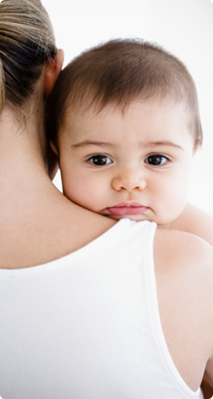
With lots of dribbles and grizzles, teething can be tough on everyone. But it’s all worth it when you see those shiny new teeth!
While they’re coming through, there’s lots of ways you can ease your little one’s pain.
How do I know if my little one is teething?
Teething can start at different ages for each baby but the first tooth normally starts coming through at around 6 months – and it’s a very proud moment! The bottom front and top front teeth usually come through first.
Look out for these common symptoms:
sore red gums where their tooth is coming through
one cheek looks or feels hot and flushed on the affected side
your baby may dribble a lot
they might be a little irritable
and you’ll probably find your baby is trying to chew anything they can get their hands on – from their favourite toys to your fingers.
How can I help them feel better?
Some children don’t have any teething problems – their teeth might come through without any trouble. Or only some of their teeth might cause them discomfort.
But others may really feel it. It can be really painful as their gums can become tender and irritable. So what’s best at any time depends on how your little one is feeling. Here are some options for you:
You could try a paracetamol-based medicine. CALPOL® Infant Suspension can be used for most babies from 2 months.
Handy tip
If your baby is eating solids, try distracting them with healthy things to chew like pieces of raw apple. If you slice and core the apple it makes for a handy homemade teething ring! Always make sure to watch your child when they are eating in case they choke.
Some more simple tips
Rubbing their gums gently with your little finger can help.
Try cooling their teething ring in the fridge, but check the manufacturer’s instructions to make sure it’s suitable to refrigerate.
Playing with your baby can sometimes distract them from the pain in their gums.
Cool drinks or soft food like yogurt can be comforting too.
How long will it last?
All babies are different, but most start teething around 6 months.
Most will have all their milk teeth by the time they are 2½ years old.
As each tooth comes through, if it does hurt they’ll probably feel uncomfortable for a few days.
Once the tooth has come through, the discomfort usually stops – and your little one has a brand new tooth to show off too!
You can keep track of the development of your child’s teeth using the handy teething chart we’ve created.
When to call the doctor
Teething pains are very common – most children have them at some point and they shouldn’t be any cause for worry or a trip to the GP.
You know your baby best though, so if they seem very out of sorts, check with your GP.
See also

Aches & pains
Every child suffers aches and pains as they’re growing up. Find out what might be causing them and what you can do to help.
Contact the HSE
For health advice and reassurance.
1850 24 1850




